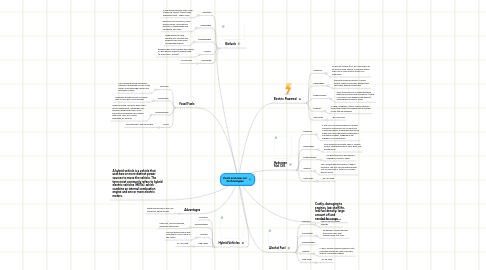
1. Advantages
1.1. Better performance, less CO2 emissions, better milage
2. A hybrid vehicle is a vehicle that uses two or more distinct power sources to move the vehicle. The term most commonly refers to hybrid electric vehicles (HEVs), which combine an internal combustion engine and one or more electric motors.
3. Biofuels
3.1. Definition
3.1.1. A fuel derived directly from living matter e.g. Starch (Corn) crops, Rapeseed crops , Sugar crops
3.2. Advantages
3.2.1. Reduced CO2 emissions, saves drivers money, less particles pollution, biodegradable and renewable, non-toxic
3.3. Disadvantages
3.3.1. Large amount of land needed, less efficient and powerful than fossil fuels, can damage engines
3.4. Inventor
3.4.1. Biodiesel was most probably discovered in 1853 by two chemists making soap (E. Duffy and J. Patrick).
3.5. Mpg range
3.5.1. 20-50 mpg
4. Fossil Fuels
4.1. Definition
4.1.1. fuel consisting of the remains of organisms preserved in rocks in the earth's crust with high carbon and hydrogen content
4.2. Advantages
4.2.1. Generates a huge amount of energy, easy to find, gas is very efficient
4.3. Disadvantages
4.3.1. Highly polluting, Produces high levels of CO2 when burnt, natural gas can produce displeasing odors, many environmental disasters are related with fossil fuels, e.g. nuclear meltdown, oil spills etc
4.4. Types
4.4.1. oal, petroleum, and natural gas
5. Hybrid Vehicles
5.1. Definition
5.2. Disadvantages
5.2.1. High cost, Low acceleration, expensive spare parts
5.3. Inventor
5.3.1. The first hybrid vehicle was invented by Victor Wouk in the 1990's
5.4. Mpg range
5.4.1. 30-100 mpg
6. Costly, damaging to engines, low shelf life, low fuel density, large amount of land needed for crops
7. Hydrogen Fuel Cell
7.1. Definition
7.1.1. A fuel cell is an electrochemical cell that converts a source fuel into an electrical current and water. It generates electricity inside a cell through reactions between a fuel and an oxidant, triggered in the presence of an electrolyte
7.2. Advantages
7.2.1. Only emissions are water vapour, Carbon neutral, greater efficiency, safe, quiet, low maintenance
7.3. Disadvantages
7.3.1. No good source of the element Hydrogen, Costly to liquid
7.4. Inventor
7.4.1. The concept was discovered in 1838 in Germany. The first functioning hydrogen fuel cell was built in 1843 by Sir William Robert Grove.
7.5. Mpg range
7.5.1. 50-150 mpg
8. Electric Powered
8.1. Definition
8.1.1. An electric vehicle (EV), also referred to as an electric drive vehicle, is a vehicle which uses one or more electric motors for propulsion
8.2. Advantages
8.2.1. Does not produce pollution, Carbon neutral, lower cost of fuel, Batteries are recyclable, high fuel efficiency
8.3. Disadvantages
8.3.1. Takes a long time to recharge batteries, Batteries are quite large and heavy (a third of a electric cars weight is the battery) , limited distance able to travel
8.4. Inventor
8.4.1. In 1828, Hungarian, Ányos Jedlik invented a small-scale model car powered by an electric motor that he designed
8.5. Mpg range
8.5.1. 80-400 Mpg
9. Alcohol Fuel
9.1. Definition
9.1.1. An alternative fuel that can be used to power vehicles
9.2. Advantages
9.2.1. Renewable, Cleaner burning than fossil fuels, high octane rating, non-toxic
9.3. Disadvantages
9.4. Inventor
9.4.1. n 1860, German inventor Nikolaus Otto uses ethyl alcohol as a fuel in an early internal combustion engine
9.5. Mpg range
9.5.1. 20-50 mpg
